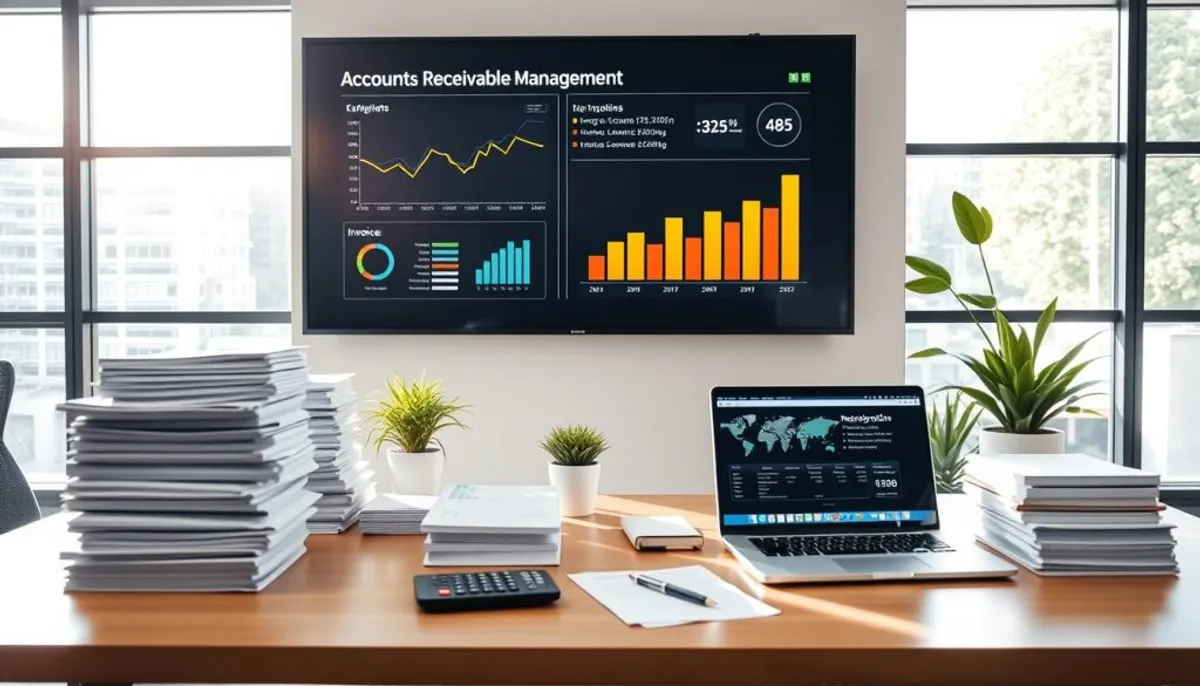In today’s fast-paced business world, managing accounts receivable poses a significant challenge. This is where accounts receivable management solutions come into play. These tools are designed to streamline AR processes, enhance cash flow, and bolster overall financial health.
With over 30 years of experience across 30+ industries, we’ve witnessed the transformative impact of effective AR management. Our clients have experienced notable reductions in Days Sales Outstanding (DSO) and aging invoices, thanks to our partnership.

Our team, comprised of seasoned AR specialists with an average tenure of 10+ years, employs advanced cash flow optimization tools. We maintain daily synchronization with your accounting software and adhere to a meticulous follow-up schedule for overdue accounts. This ensures no payment is overlooked.
Unlike automated platforms, we advocate for a proactive stance. Our experts combine phone and email outreach with proprietary software to achieve superior receivables performance. This approach, infused with a human touch, distinguishes us and fosters stronger customer relationships.
The fundamental aspects of AR management include the generation of invoices, the collection of payments, and the resolution of any disputes that may arise. Contemporary receivables processing software facilitates the automation of these tasks. This automation not only reduces manual labor but also elevates the precision of these operations.
Effective AR management is instrumental in bolstering a company’s financial standing. By embracing accounts receivable automation, businesses can expedite payment collection. This, in turn, enhances cash flow and fortifies customer relationships, contributing to overall financial stability.
Several critical metrics are employed to gauge AR performance:
By integrating accounts receivable automation and receivables processing software, businesses can monitor these metrics with ease. This capability empowers them to make informed decisions, thus optimizing their AR management strategies.
The Accounts Receivable (AR) management landscape has undergone a significant transformation. Manual processes and time-consuming paperwork are now relics of the past. Today, invoice management systems utilize advanced technology to streamline operations and enhance efficiency.
Modern collections management platforms have transformed how businesses manage their receivables. These platforms incorporate artificial intelligence and machine learning algorithms. They predict late payments and optimize collection strategies. This proactive approach has led to substantial improvements in cash flow management.
Automation is a cornerstone of contemporary AR management. These systems automate everything from invoice generation to cash application. This has dramatically reduced processing times and minimized errors. Cloud-based platforms offer real-time visibility into transaction workflows. They empower businesses with better decision-making capabilities.
The adoption of smart Software as a Service (SaaS) solutions has democratized AR management. These easy-to-implement systems provide smaller companies with access to sophisticated AR management tools. Previously, these tools were only available to larger enterprises.
Looking ahead, the integration of blockchain technology and advanced AI negotiation systems promises to further revolutionize AR management. This integration will offer even greater efficiency and accuracy in financial operations.
Adopting effective credit control solutions can revolutionize your business operations. Let’s explore the key advantages of implementing modern accounts receivable management systems.
Automated debtors ledger management accelerates payment collection, reducing Days Sales Outstanding (DSO). Companies using these systems can cut time spent on call preparation from 15% to 6%, allowing more focus on collecting payments.
Streamlined communication improves customer satisfaction. Automated invoice delivery and online payment options shorten the sales-to-payment cycle. This efficiency helps resolve 50% of invoice issues related to incorrect purchase order information.
Credit control solutions automate manual tasks, significantly reducing administrative costs. Time spent managing disputes drops from 40% to 13%, while time dedicated to payment solicitation increases from 20% to 62%.
AR management software minimizes credit risk by monitoring customer relationships and setting alerts for high-risk accounts. This proactive approach ensures better data accuracy and compliance management.

Businesses encounter numerous hurdles in accounts receivable management. These obstacles can severely impact cash flow and overall financial health. Let’s examine the primary challenges and their effects on operations.
Late payments can strain cash flow and elevate Days Sales Outstanding (DSO). Effective management involves sending reminders before due dates and contacting customers promptly upon payment delays. Offering a dedicated payment portal can streamline transactions and reduce delays.
Clear communication is essential for optimizing the receivables cycle. Providing detailed invoices and precise payment instructions helps prevent confusion. Real-time data dashboards enable better monitoring of key performance indicators, bridging information gaps between AR teams and customers.
Manual AR systems face challenges as businesses expand. This leads to increased costs from human errors and inaccurate record-keeping. Automating complex tasks and consolidating data onto a single platform can significantly enhance efficiency.
By addressing these challenges, businesses can optimize their receivables cycle and enhance overall financial performance. Implementing robust accounts receivable management solutions is crucial to overcoming these obstacles and streamlining operations.
The ti3 platform is a game-changer in accounts receivable automation. It addresses common AR challenges with a comprehensive approach to managing overdue accounts.
Ti3 is a SaaS platform designed to streamline AR processes. It tackles late payments head-on with automated reminders and efficient issue escalation. The system maintains positive customer relationships while achieving impressive collection rates.
The platform boasts an array of powerful features:
These features work together to create a robust accounts receivable automation system that significantly improves cash flow management.
Ti3 seamlessly integrates with existing financial systems, offering a smooth transition for businesses. This integration enhances overall efficiency by:
By adopting ti3, businesses can transform their AR processes, improving cash flow and customer relationships while reducing operational costs.
Introducing automation into accounts receivable management can transform your business operations. By adopting receivables processing software, companies can experience notable cost reductions and operational enhancements.
AR automation brings numerous advantages:

AR automation employs digital tools for tasks such as invoice creation, payment reminders, and cash application. This transition from manual to automated systems reduces errors and hastens the collection cycle.
Receivables processing software includes essential features:
Implementing accounts receivable management solutions can enhance cash flow, fortify customer relationships, and facilitate data-driven decision-making. Automation frees staff from mundane tasks, enabling them to concentrate on strategic initiatives and customer service.
Effective accounts receivable management is crucial for maintaining healthy cash flow. Implementing proven strategies can streamline AR processes and enhance financial stability. This approach is essential for businesses aiming to thrive financially.
Clear payment terms are vital for smooth transactions. Businesses must outline due dates, accepted payment methods, and late fees upfront. Utilizing an invoice management system standardizes these terms across all customer interactions.
Regular communication keeps customers informed and payments on track. A collections management platform automates reminders and follow-ups. This ensures timely payments without straining customer relationships.
Accurate records are vital for resolving disputes and tracking payment history. Digital solutions offer secure storage and easy access to important documents. This streamlines the AR process significantly.
By adopting these practices and leveraging technology, businesses can significantly enhance their AR management. An efficient invoice management system paired with a robust collections management platform can transform accounts receivable from a challenge into a strategic advantage.
Effective accounts receivable management relies on measuring performance through key metrics. Credit control solutions and cash flow optimization tools offer valuable insights into AR health. This enables data-driven decisions.
Several KPIs are crucial for assessing AR efficiency:
Modern cash flow optimization tools offer robust reporting features. These generate real-time insights into AR health. Businesses can track performance over time and identify areas for improvement in collections processes.
By leveraging these metrics, companies can make informed decisions to enhance their AR management. For instance, if DSO is high, a business might implement stricter credit policies or offer early payment incentives. Regularly tracking these KPIs helps identify trends, forecast cash flow, and implement targeted strategies for AR optimization.
Integrating accounts receivable automation and receivables processing software into your business operations can streamline financial processes and boost efficiency. The key to successful implementation lies in careful planning and execution.
Selecting the right solution is crucial. Consider factors like integration capabilities, scalability, and user-friendliness. Ensure the software aligns with your specific business needs and can grow with your company.
Data migration is a critical step. Audit your current data, set up accurate customer profiles, and train your staff on the new system. This process may take time but is essential for a smooth transition.
Implementing accounts receivable automation can yield significant benefits:
A phased rollout approach, starting with pilot programs, allows for adjustments based on feedback. Continuous monitoring and improvement using AR reports and performance metrics help optimize processes over time.
By carefully integrating receivables processing software, businesses can significantly reduce time spent on manual tasks. This allows teams to focus on strategic activities and improve overall financial health.
Investing in accounts receivable management solutions necessitates a thorough evaluation. Businesses must meticulously compare the initial costs with the anticipated returns. This analysis involves several critical factors.
Implementing debtors ledger management systems incurs initial expenses. These include software licensing, implementation, and staff training costs. It is imperative to include these costs in the budget for AR solutions.
The return on investment for AR automation is substantial. Companies that automate more than half of their AR processes experience a 32% reduction in days sales outstanding. This results in enhanced cash flow and quicker access to funds. Further, 63% of CFOs report a decrease in billing errors with automation.
Accounts receivable management solutions provide enduring advantages. They streamline invoicing and collection workflows, ensuring prompt invoice dispatch with clear payment terms. Real-time reporting and analytics transform AR monitoring, enabling data-driven decisions. This automation also empowers staff to focus on more strategic tasks, boosting overall productivity.
By embracing AR automation, businesses can anticipate considerable time and cost savings. They will also experience improved customer relationships and enhanced financial planning capabilities. These long-term advantages solidify the value of accounts receivable management solutions for growth-oriented enterprises.
In today’s fast-paced economy, effective accounts receivable management solutions are crucial for business success. They streamline operations, enhance cash flow, and foster positive customer relationships. The AR Pulse Check Survey of 2022 highlights that 52% of respondents strongly advocate for digitizing Accounts Receivable as a key to peak performance.
Implementing robust AR management systems can yield significant results. For example, GeBBS Healthcare Solutions dramatically reduced their A/R from $68.2 million to $14.9 million in just 11 months. This achievement highlights the transformative impact of receivables cycle optimization on financial health.
Automation and data analytics are pivotal in addressing common challenges like late payments, inaccurate invoicing, and high Days Sales Outstanding (DSO). Modern AR solutions enable real-time tracking of invoices and payments, offering valuable insights into receivable statuses. These tools seamlessly integrate with other financial systems, ensuring data consistency and facilitating powerful analytics for predicting future cash flows.
As we progress, businesses adopting advanced accounts receivable management solutions will be better equipped to excel in a competitive marketplace. By prioritizing clear communication, efficient processes, and data-driven decision-making, companies can optimize their receivables cycle and secure a stronger financial future.